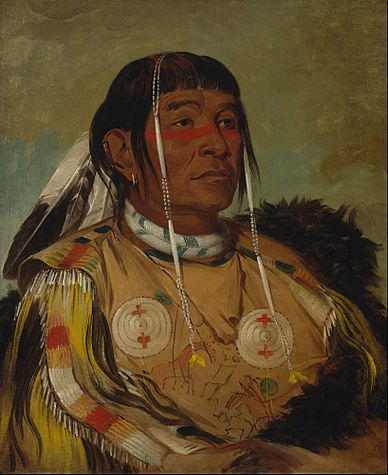Sha-có-pay facts for kids
Quick facts for kids Sha-có-pay |
|
|---|---|
 |
|
| Artist | George Catlin |
| Year | 1832 |
| Medium | Oil on canvas |
| Dimensions | 73.7 cm × 60.9 cm (29.0 in × 24.0 in) |
| Location | Smithsonian American Art Museum, Washington, D.C. |
Sha-có-pay is a famous painting by American artist George Catlin. He used oil paints to create this artwork in 1832. The painting shows a real person named Sha-có-pay. He was a chief of the Plains Ojibwe people. His name, Sha-có-pay, means "The Six" in the Dakota language.
Contents
About the Artist and Painting
Who was George Catlin?
George Catlin was an artist who loved to travel. He explored the western parts of North America. Catlin painted many Indigenous American people. At that time, these groups had little contact with non-Indigenous people. Only explorers and traders usually met them. Catlin wanted to record their lives and cultures.
What the Painting Shows
The painting of Sha-có-pay is very detailed. It shows the traditional clothes of the Plains Ojibwe people. You can see a shirt made of buckskin. It is decorated with beads and paintings. Sha-có-pay also wears a buffalo-hide robe. This robe was important for warmth and tradition.
He has eagle feathers in his hair. These feathers often showed bravery or special achievements. He also wears hair pipes and a beaded necklace. This type of necklace was special to tribes in the northern plains. These tribes included the Ojibwe and Cree. Catlin painted this portrait during a trip to Fort Union in 1832.
Catlin's Thoughts on Sha-có-pay
George Catlin wrote about Sha-có-pay. He described him as a very large man. Catlin noted Sha-có-pay's dignified manner. He also mentioned his pride and confidence.
Catlin said Sha-có-pay wore a beautiful outfit for the painting. This outfit had many decorations. These decorations were like trophies from battles he had won. They showed his bravery and strength. Catlin also described Sha-có-pay's buckskin shirt. It had beautiful embroidery and paintings. These designs told the story of his battles and his life.
See also
 In Spanish: Sha-có-pay para niños
In Spanish: Sha-có-pay para niños

